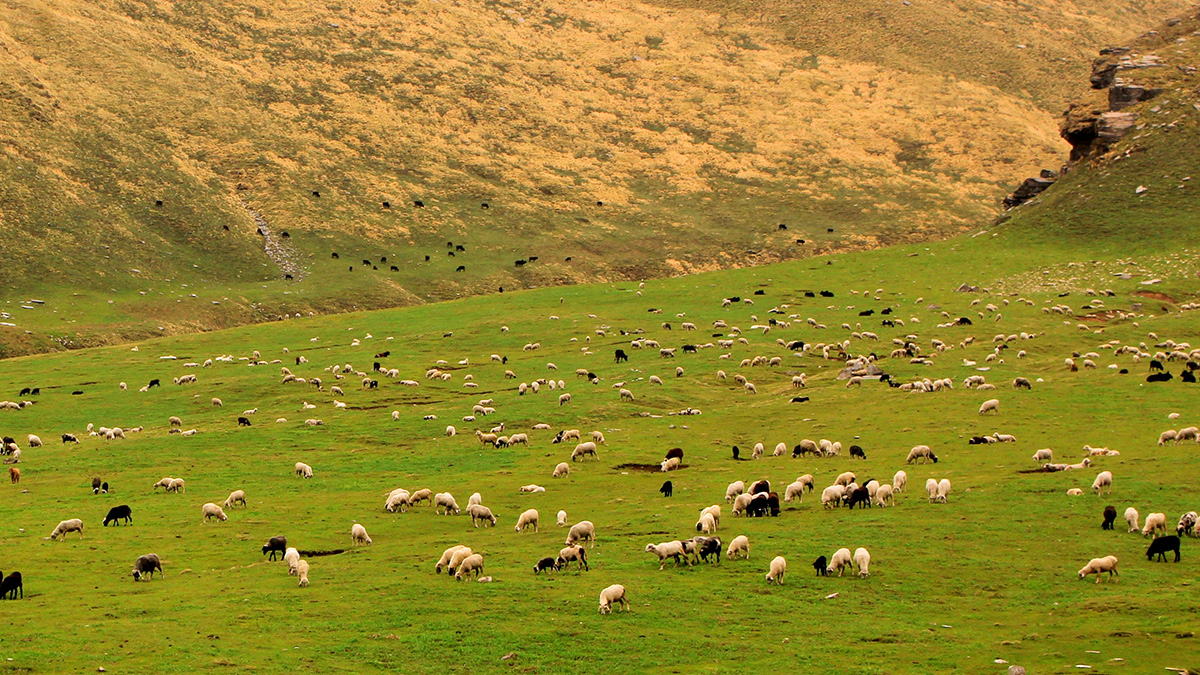In some parts of the world, livestock have supplanted wild herbivores in grasslands and savannas. Some scientists question how the change is affecting the land’s ecological functions, particularly when it comes to the changing climate and one important process: carbon sequestration.
A recent study in Global Change Biology found that veterinary antibiotics, used extensively in livestock, are limiting soil’s ability to sequester carbon in these areas. Widespread use of these medications can affect carbon cycles on a large scale and has implications for soil health and food security.
Soils Hold Carbon
Soils are carbon sinks: Plants take up carbon dioxide from the atmosphere and store it in the soil as organic matter. Animals play a key role by consuming and returning plants into the ground.
To find out how livestock are altering this process, a group of researchers undertook a 12-year study in the Spiti region of the northern Indian state of Himachal Pradesh. The area is part of the Trans-Himalayan ecosystem, a high-altitude landscape with glacially fed rivers, grasslands, and snow-covered mountains that extends north onto the Tibetan Plateau. Traditional pastoralism, which involves grazing livestock across patches of land, and agropastoralism, which also includes crop farming, are dominant livelihoods in the region. The researchers took advantage of this to test the effect of the domesticated animals on the soil under their hooves.
Starting in 2005, the researchers set up 30 enclosures throughout eight watersheds: four dominated by wild herbivores (yak, ibex, wild ass, and two species of wild sheep) and four with primarily livestock (yak-cattle hybrids, cattle, goats, sheep, horses, and donkeys). They then measured the mass of the microbes living in the soil and their respiration rate and the total soil organic matter inside and outside the enclosures.
“Antibiotics are stable compounds, so they don’t decompose easily.”
The authors found that microbial carbon use efficiency, which is a measure of how well microbes are using carbon, was 19% lower in areas where livestock grazed. Low carbon efficiency, like poor fuel efficiency in cars, means more of the carbon added to the soil is respired by microbes and less is stored. Lower efficiency leads to higher carbon turnover (i.e., lower sequestration capacity) because the residence time of carbon in the soil is shorter. Areas used by livestock contained 1.5 kilograms less carbon per cubic meter of soil compared with areas used by native herbivores.
The difference is due to veterinary antibiotics, according to the researchers. These medications are used to keep livestock healthy and end up in the soil via dung. The antibiotics kill some microbes and allow others to take their place. Generally, there are more than a thousand species of microbes in even a pinch of soil, all interacting with each other. Antibiotics disrupt such regular interactions. And because these microorganisms are key to carbon sequestration—they feed on nutrient-rich soil organic matter and bury fractions of it in the soil—antibiotic usage leads to a reduction in sequestration capacities.
“Antibiotics are stable compounds, so they don’t decompose easily,” said Sumanta Bagchi, an ecologist at the Indian Institute of Science and a coauthor of the study. The effect is therefore long-lasting, as are other impacts such as the chemical compounds in antibiotics making their way into nearby water bodies.
Nonpoultry meat production in India is still dominated by traditional pastoralism and agropastoralism, as is around half of milk production, so large industrial livestock ranches are not common. Trends pointing to large-scale usage of antibiotics are therefore a result of large numbers of livestock grazing, not of intensive livestock farming, said Bagchi. Even so, there is cause for concern given excessive usage of antibiotics.
Far-Reaching Effects
Traditional pastoralism can be a good substitute for some ecosystem functions provided by wild herbivores “because communities have learned how to effectively manage livestock,” Bagchi said. But, he explained, the team found that even under such traditional systems, livestock can help sequester only around 70% of carbon in soils compared with wild herbivores.
In agropastoral systems where dung is used in fields as manure, agricultural soils are also exposed to antibiotic pollution. As a result, carbon sequestration can be diminished, with implications for agricultural productivity.
“We need carbon in the soil for microbial activities to keep the soil healthy.”
The study was conducted on the geographical margins of the country. The measurable effect of antibiotics even in this remote area showed the extent of the problem. The authors pointed to a need for similar assessment of the impacts of antibiotic usage across the country. “If the findings are more broadly applicable, it has serious implications for carbon sequestration across India’s grasslands,” said Abi Vanak, an ecologist at Ashoka Trust for Research in Ecology and the Environment.
“We need carbon in the soil for microbial activities to keep the soil healthy,” Vanak said. “So [the study has] implications beyond carbon sequestration for climate reasons,” he said.
Prashanth Srinivas, a researcher at the Institute of Public Health in Bangalore, said the paper holds “huge ramifications” for animal and human health and other issues like soil health and food security. “Antibiotics are necessary to maintain livestock health, but they must be used judiciously,” he said.
—Rishika Pardikar (@rishpardikar), Science Writer

